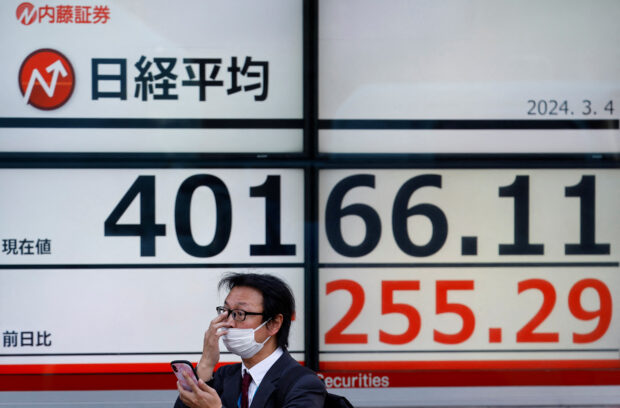
A man uses a smartphone in front of an electronic screen displaying Japan’s Nikkei share average outside a brokerage in Tokyo, Japan March 4, 2024. REUTERS/Kim Kyung-Hoon/File Photo
BEIJING — Asian shares were mostly lower on Monday after Wall Street’s huge rally faltered last week.
Japan’s Nikkei 225 index shed 2.2 percent to 38,820.49. The government issued revised figures showing the economy grew 0.1 percent in the last quarter of the year, better than the minus 0.1 percent reported earlier but lower than forecasts.
That means the economy is not in a technical recession, though it’s expanding at a snail’s pace.
READ: Japan Q4 GDP revised up to slight expansion, economy avoids recession
Hong Kong’s Hang Seng rose 1.4 percent to 16,574.65 and the Shanghai Composite was up 0.2 percent to 3,052.38.
China’s National People’s Congress concludes later Monday with no major changes of policy expected. The mostly ceremonial body endorses decisions set by top leaders of the ruling Communist Party.
Elsewhere in Asia, South Korea’s Kospi fell 0.8 percent to 2,659.53 and the S&P/ASX 200 in Australia gave up 1.8 percent to 7,704.20.
On Friday, the S&P 500 fell 0.7 percent from its all-time high set a day before, closing at 5,123.69. The Dow dropped 0.2 percent to 38.722.69, and the Nasdaq slid 1.2 percent to 16,085.11.
Shares initially climbed after mixed data on the U.S. job market bolstered hopes that easier interest rates will arrive later this year. Later, it swung to a loss after one of the most influential stocks, Nvidia, took a rare stumble following a jaw-dropping surge that critics said was overdone.
Friday’s dip also sent the S&P 500 to a rare losing week, just its third in the last 19.
U.S. jobs report
The jobs report showed employers hired more workers last month than expected, but wages for workers rose by less than forecast. It also said job growth in January was not nearly as hot as earlier thought.
READ: US labor market steadily easing as job openings, resignations decline
The overall economy is in a delicate spot, where it needs just the right amount of growth to avoid recession but not raise pressure on inflation.
The ultimate goal is for prices to cool enough to convince the Federal Reserve to lower its main interest rate from its highest level since 2001 and relieve pressure on the financial system and the economy.
Lower interest rates encourage people and companies to borrow, which can strengthen the economy. That boosts prices for stocks and other investments.
Fed Chair Jerome Powell has said the central bank is “not far” from cutting interest rates and just needs more data confirming that inflation is really falling to its 2 percent target.
The hope on Wall Street is that the remarkably resilient economy will drive growth in profits for companies.
On Friday, gun maker Smith & Wesson Brands leaped 29.4 percent after reporting stronger profit than expected for the latest quarter. It said its shipments grew faster than the overall firearms market.
Nvidia in the spotlight
But Nvidia was the main stock in the spotlight as it tumbled 5.5 percent for its worst day since May. It’s a rare blip for the stock that has shot up nearly 77 percent this year after more than tripling last year.
READ: Nvidia replaces Alphabet as Wall St’s third most valuable company
Because Nvidia has swelled into the third-largest U.S. stock, it carries much more weight on the S&P 500 than nearly every other. That buoyed Wall Street on the way up but leaves it vulnerable to pullbacks, particularly when critics say stocks caught up in the market’s frenzy around artificial intelligence have shot up too far, too fast.
Also on the losing end was Broadcom, which fell even though it reported stronger results than expected. It dropped 7% after giving a forecast for revenue this upcoming year that was a touch below analysts’ expectations.
Costco Wholesale sank 7.6% after its revenue for the latest quarter fell shy of forecasts.
In other trading early Monday, U.S. benchmark crude oil shed 42 cents to $77.59 per barrel in electronic trading on the New York Mercantile Exchange. It fell 92 cents to $78.01 a barrel on Friday.
Brent crude oil, the international standard, declined 34 cents to $81.74 per barrel.
The U.S. dollar fell to 146.99 Japanese yen from 147.07 yen. The euro was down to $1.0936 from $1.0941.